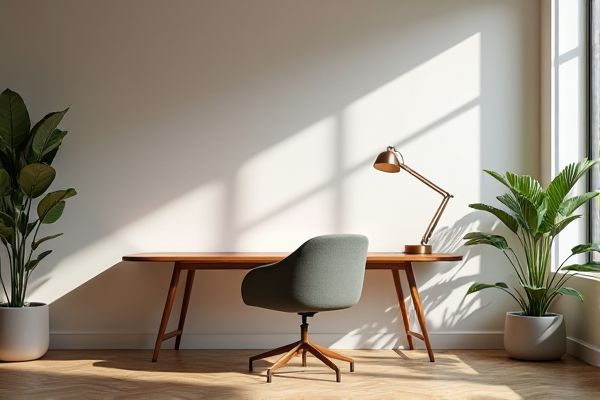
A study table is designed primarily for students, featuring compact sizes and compartments tailored for books and stationery, whereas an office table is built for professionals, offering larger surfaces and space for computers and office equipment. Explore the rest of the article to discover which table best suits Your needs and workspace.
Table of Comparison
| Feature | Study Table | Office Table |
|---|---|---|
| Primary Use | Reading, writing, and studying | Work tasks, meetings, and computer use |
| Design | Compact, minimalistic, often with bookshelves or drawers | Larger surface, ergonomic, often with cable management |
| Materials | Wood, MDF, or plastic | Wood, metal, glass, or composite materials |
| Size | Small to medium, fits in bedrooms or study rooms | Medium to large, designed for office spaces |
| Ergonomics | Basic, focus on study comfort | Advanced, adjustable height and angles |
| Storage | Limited, mainly drawers or shelves for books | Ample, including filing cabinets and organizers |
| Price Range | Affordable to mid-range | Mid-range to premium |
| Typical Users | Students, home learners | Professionals, office workers |
Introduction: Study Table vs Office Table
Study tables are designed primarily for personal use, featuring ergonomic layouts and storage tailored for books, stationery, and laptops to support focused learning sessions. Office tables prioritize professional functionality, often larger with cable management systems, multiple drawers, and space for monitors, printers, and other work equipment to enhance productivity. Your choice depends on whether the primary purpose is academic study or workplace efficiency, influencing the design and features of the table.
Design and Aesthetics Differences
Study tables typically feature minimalist designs with compact dimensions and functional storage tailored for focused tasks, while office tables prioritize ergonomics and professional aesthetics, often incorporating larger surfaces and cable management systems. Materials for study tables lean towards lightweight wood or engineered composites, emphasizing simplicity and affordability, whereas office tables use premium finishes like polished wood, metal accents, or glass to convey a corporate ambiance. Your choice depends on balancing practicality for study activities against the sophisticated appearance needed for a formal office environment.
Material Composition and Durability
Study tables are commonly crafted from lightweight materials like MDF or particleboard, offering affordability but moderate durability. Office tables often use sturdier materials such as solid wood, metal, or high-quality laminate, ensuring enhanced longevity and resistance to wear from daily use. Choosing the right table for your space depends on balancing material composition with the desired durability for your work or study needs.
Ergonomics and Comfort
Study tables prioritize adjustable height and proper legroom to promote ergonomic posture during long hours of concentrated tasks, reducing strain on the back and neck. Office tables often incorporate built-in cable management and adjustable features to accommodate electronic devices, enhancing comfort and productivity in a professional environment. Both types emphasize ergonomic design, but office tables focus more on facilitating multitasking with accessories for better comfort throughout the workday.
Storage Options and Organization
Study tables often feature built-in shelves, drawers, and compartments tailored for books, stationery, and study materials, enhancing efficient organization for students. Office tables typically prioritize larger storage spaces like file drawers and cable management systems designed to keep documents, office supplies, and electronic accessories orderly. Both table types aim to maximize workspace productivity through specialized storage solutions suited to their respective uses.
Space Utilization and Room Placement
Study tables are typically compact with built-in storage solutions like shelves and drawers, maximizing space utilization in smaller rooms or dedicated study areas. Office tables often prioritize surface area for multiple monitors and paperwork, requiring more room placement consideration to ensure ergonomic seating and accessibility. Your choice should balance available space with functional needs, positioning the table to optimize workflow and comfort.
Purpose and Functionality
Study tables are designed primarily for focused tasks like reading, writing, and homework, featuring compact surfaces and storage for books and stationery. Office tables prioritize ergonomic comfort and space for computers, documents, and multitasking equipment to boost productivity in professional settings. Your choice depends on whether you need a dedicated space for academic work or a versatile area for office tasks.
Price Range and Budget Considerations
Study tables generally range from $50 to $300, offering affordable options suitable for students and home use. Office tables, designed for professional settings, typically cost between $150 and $800 due to sturdier materials and ergonomic features. Budget considerations should factor in durability, size, and additional functionalities that justify the higher price of office tables.
Ideal Users and Target Audience
Study tables are designed primarily for students, children, and individuals who require a compact workspace for reading, writing, and computer use; their target audience includes school-aged children, college students, and home learners who need a functional yet space-saving design. Office tables cater to professionals, business people, and remote workers, offering ergonomic features, ample surface area, and cable management systems to support long hours of work and multiple electronic devices. The key difference lies in their intended use: study tables emphasize simplicity and focus for academic tasks, while office tables prioritize productivity and comfort for professional environments.
Conclusion: Choosing the Right Table for Your Needs
Choosing the right table depends on your specific needs: a study table is designed for focused academic tasks with compact storage and ergonomic features, while an office table caters to professional work with larger surfaces and space for multiple devices. Your choice should consider functionality, space, and the type of activities to maximize productivity and comfort. Investing in the appropriate table enhances organization and supports your daily workflow effectively.
 homyna.com
homyna.com